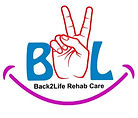MINIMIZING FALLS OF OLDER ADULTS -An interview with B2LCARE'S Physiotherapist SUJATA MUDI
- b2lcare

- Jun 4, 2020
- 3 min read

Q: What are some simple exercises aging adults can do to improve balance?
A: Age-related decline in balance is due to a variety of factors including impaired vision, limited range of motion, decreased strength, flexibility, and endurance, and poor posture. A few exercises I often recommend are:
Sit & Stand: From a chair with two arm rests, push up with your arms to a standing position from a sitting position. Repeat 5 times. Advance this exercise by doing a sit-to-stand without using your arms.
One-Leg Balance: Hold onto a stable surface and stand on one leg. Hold for five counts. Then try it on the other leg. Repeat 3 times on each leg. To make this harder, you can try it with your eyes closed.
Eye Tracking: Sit in a chair and hold a finger an arm’s length away from your face. Move it slowly from side to side, then up and down and track it with your eyes. Then try this exercise while standing and holding onto a stable surface.
Up & Down: Hold onto a stable surface and raise your heels; hold for a count of 3. Then raise your toes and hold for a count of 3. Repeat.o Tightrope: Practice walking in a straight line, placing one foot in front of the other (heel to toe and toe to heel).
Core and Posture Strengthener: Get on all fours and raise one arm up and then the other. Then raise one leg up and then the other. Try raising one arm up at the same time as you raise your opposite leg.
Q: What is the number one recommendation you give to patients to avoid falls?
A: Be proactive. If you start to feel unsteady, visit a physical therapist for a balance assessment.
Q: Do fall-induced injuries increase at particular times during the year?
A: When the weather turns colder, we see a higher incidence of fall-related injuries. In the autumn, falling leaves can make for slippery conditions and ice can be hazardous. In addition, people tend to stay indoors during cold weather and this limits their mobility which can lead to poor stability and strength, etc.
Q: What do you hear from your aging adult patients as the most common reasons for falls—and what are some tips to prevent these?
A:“I lost my balance.”—The best advice I can give is to get a balance assessment by a physical therapist to determine what adjustments they need for better balance.
“I tripped on something.” –Remove all tripping hazards like area rugs, wires, and clutter. Make sure walkways are clear.
“I fell in the bathroom.”—More often than not,this is due to poor lighting. Make sure you have nightlights strategically placed in bathrooms,hallways, and stairs. Also be sure that grab bars are installed in key areas.
“I didn’t see it.” –I recommend that patients get their vision checked annually.
Q: What is the most common injury to aging adults as a result of a fall?
A: The Centers for Disease Control and Prevention report that 250,000 individuals aged 65 years and older are hospitalized for hip fractures each year. More than 95% of those are caused by a fall. A hip fracture often leads to surgery followed by 2-8 weeks of inpatient rehabilitation. After that, a patient may need 2-4 weeks of in-home rehabilitation, followed by few weeks of outpatient rehab. The process is long and can be prevented.
Q: If you had one thing to share with aging adults during Fall Prevention Month, what would it be?
A: If you don’t use it, you will lose it! A balance program that incorporates strength, flexibility, endurance, and balance training is essential in creating and maintaining good balance and
reducing the risk of falls.
By Back to life(B2LCARE) health care at home
Share this story through facebook/Twitter/LinkedinGoogle+PinterestEmail
















I was diagnosed with Parkinson’s disease four years ago. For over two years, I relied on Levodopa and several other medications, but unfortunately, the symptoms kept getting worse. The tremors became more noticeable, and my balance and mobility started to decline quickly. Last year, out of desperation and hope, I decided to try a herbal treatment program from NaturePath Herbal Clinic. Honestly, I was skeptical at first, but within a few months of starting the treatment, I began to notice real changes. My movements became smoother, the tremors subsided, and I felt steadier on my feet. Incredibly, I also regained much of my energy and confidence. It’s been a life-changing experience I feel more like myself again, better than I’ve…